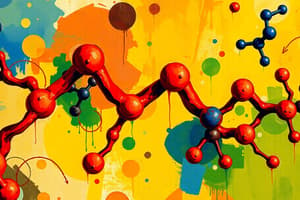Podcast
Questions and Answers
What is the primary function of cellulose in plants?
What is the primary function of cellulose in plants?
- Provide structural support (correct)
- Insulate the body
- Energy storage
- Make up the cell membrane
Which type of fats are mainly animal-based and solid at room temperature?
Which type of fats are mainly animal-based and solid at room temperature?
- Unsaturated fats
- Trans fats
- Polyunsaturated fats
- Saturated fats (correct)
What is the main function of proteins in the body?
What is the main function of proteins in the body?
- Transport molecules in and out of the cell (correct)
- Insulate the body
- Store energy
- Provide structural support in plants
Which biomolecule is primarily hydrophobic and does not dissolve in water?
Which biomolecule is primarily hydrophobic and does not dissolve in water?
What element is present in proteins but not in lipids or carbohydrates?
What element is present in proteins but not in lipids or carbohydrates?
What is the primary function of carbohydrates?
What is the primary function of carbohydrates?
What is the most common organic molecule?
What is the most common organic molecule?
Which element ratio is found in carbohydrates?
Which element ratio is found in carbohydrates?
Which type of carbohydrate is formed in the liver?
Which type of carbohydrate is formed in the liver?
What is the function of starch?
What is the function of starch?
What must molecules, atoms, or ions possess in order for a reaction to occur?
What must molecules, atoms, or ions possess in order for a reaction to occur?
Which theory states that the reactants must pass through a high-energy, short-lived intermediate state called the transition state for a reaction to occur?
Which theory states that the reactants must pass through a high-energy, short-lived intermediate state called the transition state for a reaction to occur?
Which type of reaction releases energy through bond forming?
Which type of reaction releases energy through bond forming?
What is the primary difference between exothermic and endothermic reactions?
What is the primary difference between exothermic and endothermic reactions?
What is the relationship between heat of reaction and energy of products and reactants?
What is the relationship between heat of reaction and energy of products and reactants?
How does an increase in reactant concentration affect the rate of reaction according to collision theory?
How does an increase in reactant concentration affect the rate of reaction according to collision theory?
What is the impact of temperature on reaction rate?
What is the impact of temperature on reaction rate?
How does an increase in surface area affect reaction rate?
How does an increase in surface area affect reaction rate?
What is the function of catalysts in a chemical reaction?
What is the function of catalysts in a chemical reaction?
Flashcards are hidden until you start studying
Study Notes
Functions of Biomolecules
- Cellulose: Primary structural component in plant cell walls, providing rigidity and support.
- Animal-based Fats: Primarily saturated fats, which are solid at room temperature and commonly found in animal products.
- Proteins: Essential for numerous bodily functions, including building and repairing tissues, transporting molecules, and regulating biochemical reactions.
- Hydrophobic Biomolecule: Lipids are primarily hydrophobic and do not dissolve in water.
Elements in Biomolecules
- Unique Element in Proteins: Nitrogen is present in proteins but absent in lipids and carbohydrates.
- Function of Carbohydrates: Serve as a primary energy source and structural materials in cells.
- Most Common Organic Molecule: Glucose, a simple sugar vital for energy metabolism.
- Carbohydrate Element Ratio: Composed of carbon, hydrogen, and oxygen in a 1:2:1 ratio.
Carbohydrate Formation and Functions
- Carbohydrate Formation in Liver: Glycogen is synthesized and stored in the liver for energy.
- Starch Function: Acts as an energy storage molecule in plants.
Reaction Mechanisms and Theories
- Reaction Requirements: Molecules, atoms, or ions must collide with sufficient energy for a reaction to occur.
- Transition State Theory: States that reactants must pass through a high-energy, short-lived transition state to be converted into products.
- Exothermic Reactions: Release energy during bond formation, often resulting in a temperature increase.
Reaction Dynamics
- Exothermic vs. Endothermic: Exothermic reactions release energy, while endothermic reactions absorb energy.
- Heat of Reaction: Determines the difference in energy between reactants and products; exothermic has lower energy products than reactants, while endothermic has higher.
- Reactant Concentration Impact: Increasing reactant concentration raises the rate of reaction due to more frequent collisions.
- Temperature Effect: Higher temperatures typically increase reaction rates by providing more energy for collisions.
- Surface Area Influence: A larger surface area of reactants enhances the reaction rate due to increased exposure and collisions.
Catalysts in Reactions
- Catalysts Function: Speed up chemical reactions without being consumed by lowering the activation energy required.
Studying That Suits You
Use AI to generate personalized quizzes and flashcards to suit your learning preferences.




